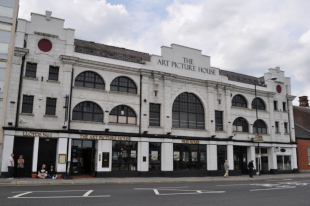Jimmy Murray (JM-95-039)

The Art Cinema, Bury. Public Domain License via cinematreasures.org
Early in 1995, Jimmy Murray responded to a call for volunteers to take part in Cinema Culture in 1930s Britain, and was among the twenty-two individuals living in the Greater Manchester area who were interviewed for the project as core informants during 1995. Born in Bury in 1920, aside from a period of war service he lived in the area all his life. His father worked as a fireman on locomotives and his mother was a housewife. On leaving school at fourteen, Mr Murray followed his father into the railways, firstly as a fireman and later as stoker. He was interviewed in his home in Bury on 9 May and 5 September 1995.
In his first interview, Mr Murray offers extensive recollections of cinemagoing in the late silent and early sound periods--mainly in Bury but also occasionally in Manchester city centre. He rarely if ever went to the cinema with his parents, he says, but mainly attended with friends: he remembers himself and his friends avoiding paying for admission by sneaking each other in through toilet windows. He mentions Birth of a Nation playing in Bury, with different screening days for men and women. He talks about silent films accompanied by live musicians and cinema organ recitals by Sidney Torch and Sandy MacPherson, and recalls seeing films overseas during WW2, including screenings in a makeshift corrugated-iron hut on an Icelandic military base. He names some favourite stars, both male and female, and remembers Anna Neagle visiting Bury in 1936 to open the Odeon there. The interview concludes with a long discussion of foreign travel. Mr Murray's second interview is focused more closely on cinema history, with particular attention given to film stars, of whom forty or so are named in the course of the conversation. Of actors in British films, he highlights his particular appreciation of fellow Lancastrians George Formby and Gracie Fields, stressing a preference for stars who seemed like "ordinary people". At the same time, he notes that he enjoyed the spectacle and the artifice of Hollywood musicals, and was particularly impressed by Astaire and Rogers as well as by the short ‘aquamusicals’ that the swimmer Esther Williams appeared in, drawing insightful comparisons between the glamorous settings of the films and his home town's more down-to-earth locales. He recalls film-inspired children's games of Cowboys and Indians involving sticks and cap guns, and older boys deploying trilby hats and cigarettes to emulate characters in gangster movies. His conclusion is that cinema was an important part of his childhood--to the extent that his schooling might well have suffered as a result, but that it occupied a less central place in his adult life.Interview transcript | Listing of cinemas, films and stars mentioned
Audio-synced interview (2 of 2)
Interview transcript | Listing of cinemas, films and stars mentioned
Documents, Memorabilia and Related Links
Greater Manchester home pageScan of document (JM-95-039PW001) | Transcript
Palais de Dance/Castle cinema (manchesterbeat.com site - scroll down for photos)
Sidney Torch plays "Our Love Affair" on the Wurlitzer (YouTube)
Ripley's 'Believe It Or Not' (YouTube)
Publication drawing on Mr Murray's interview (Ch 7: 'An Invitation to Dance'):
Kuhn, A. (2002). An Everyday Magic: Cinema and Cultural Memory. London: I.B. Tauris.